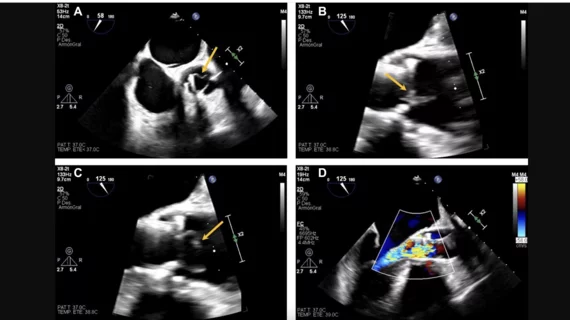TAVR valve’s spontaneous leaflet rupture highlights importance of long-term follow-up
Cardiologists in Spain encountered an unexpected complication in a 78-year-old transcatheter aortic valve replacement (TAVR) patient, highlighting the experience in JACC: Cardiovascular Interventions.[1]
Nearly six years after receiving an Acurate TF TAVR valve from Boston Scientific to treat his severe aortic stenosis, the patient presented to his local emergency department due to a “sudden, intense murmur” that was later confirmed by cardiologists. He had experienced dyspnea the previous week, including a “slight exercise limitation,” but no additional symptoms.
Transthoracic echocardiography detected signs of severe aortic regurgitation with normal biventricular ejection fraction, and transesophageal echocardiography identified a tear in the valve’s noncoronary leaflet.
The patient was then treated with redo TAVR and discharged three days later.
Lead author Joaquín Vila-García, MD, a cardiologist with La Paz University Hospital in Madrid, and colleagues highlighted what made this case so unusual.
“To the best of our knowledge, this is the first reported case of a spontaneous rupture of a leaflet in this model of valve,” the authors wrote. “Although the mechanisms leading to spontaneous leaflet rupture are unknown, we hypothesize that it may result from structural degeneration of the leaflets. This degeneration can lead to loss of mobility, and eventually, the increased pressure gradients can cause calcified leaflets to rupture.”
The group added that heart valves made with porcine tissue, such as the valve this patient received, are “more prone to deterioration due to leaflet tearing” than bovine valves.
“Bovine valves, however, tend toward leaflet thickening, resulting in valvular stenosis,” the group wrote.
Vila-Garcia also shared some key takeaways from this patient encounter that heart teams around the globe should keep in mind.
“This case highlights the importance of long-term follow-up of patients after TAVR, as even those without traditional risk factors for valve degeneration can experience unexpected complications,” the researchers wrote. “The successful management of this patient with a valve-in-valve procedure also emphasizes the potential for percutaneous interventions in addressing complex TAVR-related issues, reinforcing the evolving role of TAVR in clinical practice.”
Click here for the full story.

